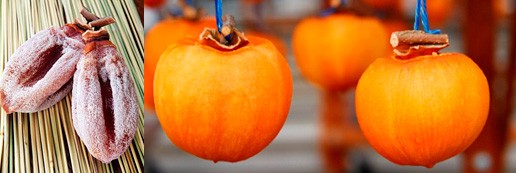
Popular "Confectionary"
A scenic temple named Zuirin-ji lies near Mino-Kamo railway station in Gifu Prefecture, central Japan. The historical temple enshrining successive shoguns and heads of ancient governments is popularly called the Kaki Temple by local residents. The transoms of the temple's main hall bear kaki motifs, while baskets that were used to offer kakis to the imperial family are still displayed in a corner of the room. An old map preserved at the temple indicates two kaki-producing sites, one of which is located at the back of the temple. The resident priest says the sites were places where dried kakis were made. The village of Hachiya, where the temple is located, offered dried kakis to the shogun every year as an officially recognized confectionary manufacturer for the Edo shogunate.
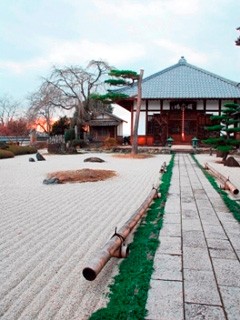
Why was the dried kaki treated as confectionary? The reason dates back to the time before Japan began to buy expensive sugar from abroad in exchange for silver and copper. The sugar trade continued after Japan cut off most of its ties with other countries in the seventeenth century, but after silver and copper supplies became depleted in Japan, a man succeeded in creating sugar by growing ocarina plants and turning them into sugar, a technique he learned in China after accidentally drifting there on a boat. Sugar making subsequently gradually spread in Okinawa and western Japan, but before this time, dried kakis were the only form of sweetening in the country, except for honey.
The Kaki Temple hosts a tea ceremony featuring dried kakis every January. This annual event is proof that the local community takes great care to maintain its tradition of making dried kakis as a chief product of the town of Hachiya.
The school song of Hachiya Elementary School, located next to the temple, was composed by novelist Shoyo Tsubouchi, a leading literary figure in the early twentieth century. The words of the song are now displayed on a black granite monument that stands in the schoolyard. The song describes the district's kakis as being so renowned that they were presented to the imperial court a thousand years ago. This is corroborated in a document written by an eleventh-century scholar, who describes the delivery of dried kakis to the court from Minokuni, where Hachiya lies.
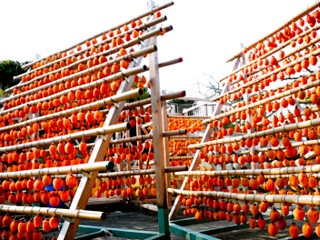
When the temple was built in the early sixteenth century, its founding priest Jinsai donated dried kakis to the Ashikaga shogunate. Records say that the shogun was so impressed that he conferred to it the name of "Kaki Temple" The sixth resident priest, Meikyu, who sympathized with the high customs the villagers had to pay the central government, negotiated with the authorities and won a concession from Shogun Toyotomi Hideyoshi exempting the villagers of 5 to (375 kilograms) of rice duties for every 100 Hachiya kakis offered.
Threats to Survival
Dried kakis, which were much loved by rulers in Japan, were also popular among foreigners. Luis Frois, a sixteenth century Christian missionary from Portugal, was served dried Hachiya fruits by Oda Nobunaga, the national's military leader at the time, according to Frois's book entitled Historia de Iapan . In 1900 Hachiya kakis were presented by the Japanese government at the World Exhibition in Paris and won a silver medal. This probably contributed to the popularization of the word kaki in Europe. Novelist and poet Hermann Hesse is said to have been greatly fond of the fruit as well.
There were two occasions, though, when the very survival of the Hachiya kaki came under threat. In the first few decades of the twentieth century, the spread of silkworm culture as a state industry swept away many kaki plantations. In the village of Hachiya, about 30 kaki-growing households turned their lands into mulberry fields to feed the silkworms. Kaki growing was preserved, though, thanks to Toshio Murase, who, as a 20 year old in 1930, decided to devote his life to reviving the Hachiya kaki. Murase as a boy had learned to make dried kakis at secondary school and felt that it was his calling to make the product. Local elementary schools in this area still maintain this tradition of teaching children to make dried kakis.
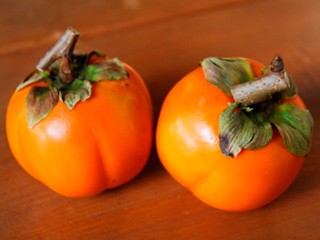
Young Murase listened to the recollections of elderly members of the community and gradually increased his stock of kaki trees. His passion never waned even when he was sent to the battlefield in World War II. From the front he wrote to his wife about fertilizer to be fed to his trees.
As food ran out during and after the war, grain replaced kakis in the fields, as the fruit was seen as luxury item. Trees surrounding the fields were turned into firewood. The Murakami family, however, devotedly held on to the kaki legacy. Later, in 1978, Toshio called on the local community to establish an organization to promote Hachiya kakis, which helped to further revive dried-kaki making. In 2007 the Hachiya kaki was admitted into the global "Ark of Taste" by Slow Food, a foundation based in Italy, as an esteemed food heritage of humankind.
In recent years, the Hachiya kaki has been going through another critical phase. The kaki is one of the few fruits that are native to Japan and has long been the predominant sweetening agent. Kaki fruits hanging in front of a farmhouse for drying during the winter remind many Japanese people of landscapes they knew as children. However, in the past 10 years or so, this tradition of kaki hanging has virtually been replaced by wheeled platforms, invented to protect precious dried fruits from the elements. Yet, some households still hang their kakis for their own consumption.
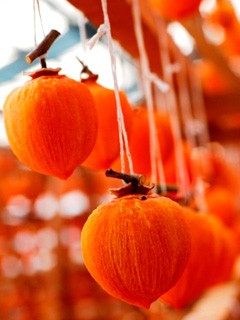
In one of his haiku, the seventeenth century poet Basho wrote, "In the old villages, no house is without its kaki tree." Such a rural scene, however, is now quite rare. About 45% of the growing area is shared with such commercial species as fuyugaki , seedless hiratanenashigaki and tonewase . Many local species, said to have once numbered a thousand nationwide, have been rapidly disappearing.
Factors behind these trends include, on the consumers' side, the market dominance of imported sugar; the invention of artificial sweeteners, such as saccharin; and a drastic increase of excessively sweetened foods produced by chain stores and factories of Western-style confectionaries. Even beverages include huge amounts of sugar. As a result, dried kakis have lost not only their status as the main domestic sweetener but also patrons capable of appreciating their delicate sweetness and subtle bitterness.
What is more worrying is the problem of successors. About 80 farmers now produce Hachiya kakis, and 46 are capable of processing them into dried fruit. The average age of these farmers, though, is 74. Few are young and ambitious, save for the grandson of Toshio Murase and his spouse. In 2002, a year blessed by good weather, shipments reached a record 8,400 cases of 1.5-kilogram kakis. This has not been surpassed in recent years, though, and shipments remain unstable. This represents a renewed crisis for the fruit, which is the pride of Hachiya - having been immortalized by Shoyo Tsubouchi - and of Japan as a whole. (This article was first published on June 2, 2008.)
Photo: Yasuko Fujisawa
